It could be challenging to distinguish between Marble Queen and Snow Queen pothos. However, these two plants differ in a few ways, even though they belong to one family. Read on and let’s take a deep dive into snow queen vs marble queen pothos.
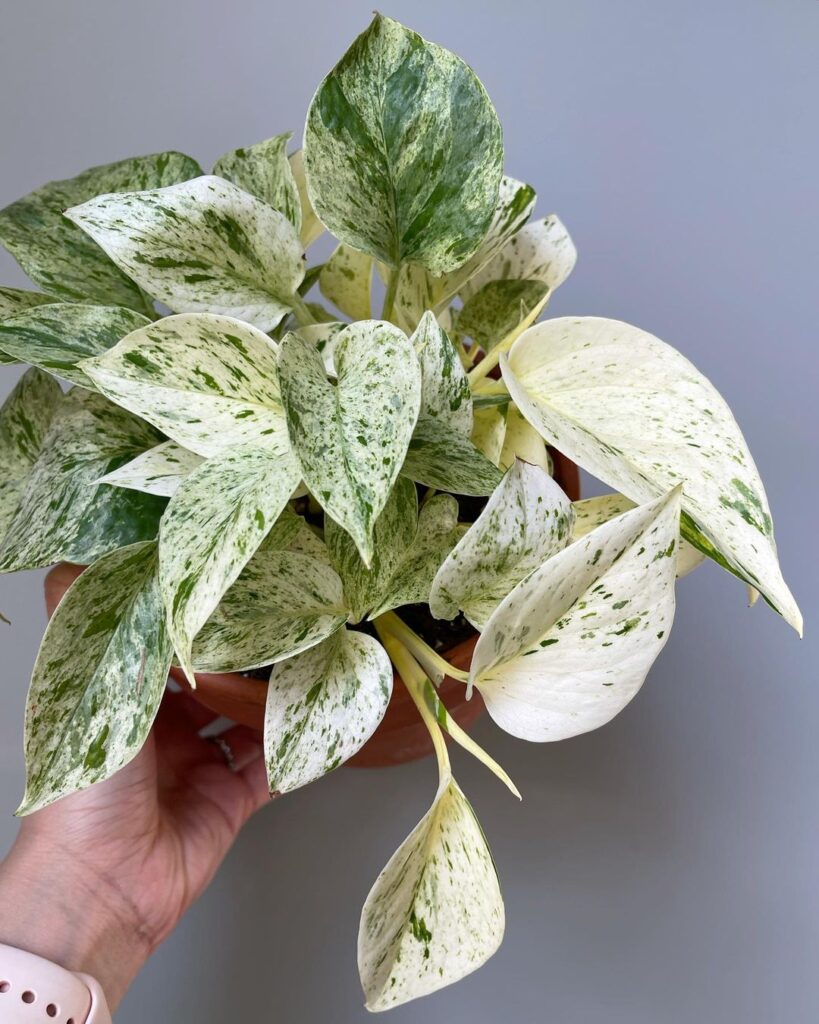
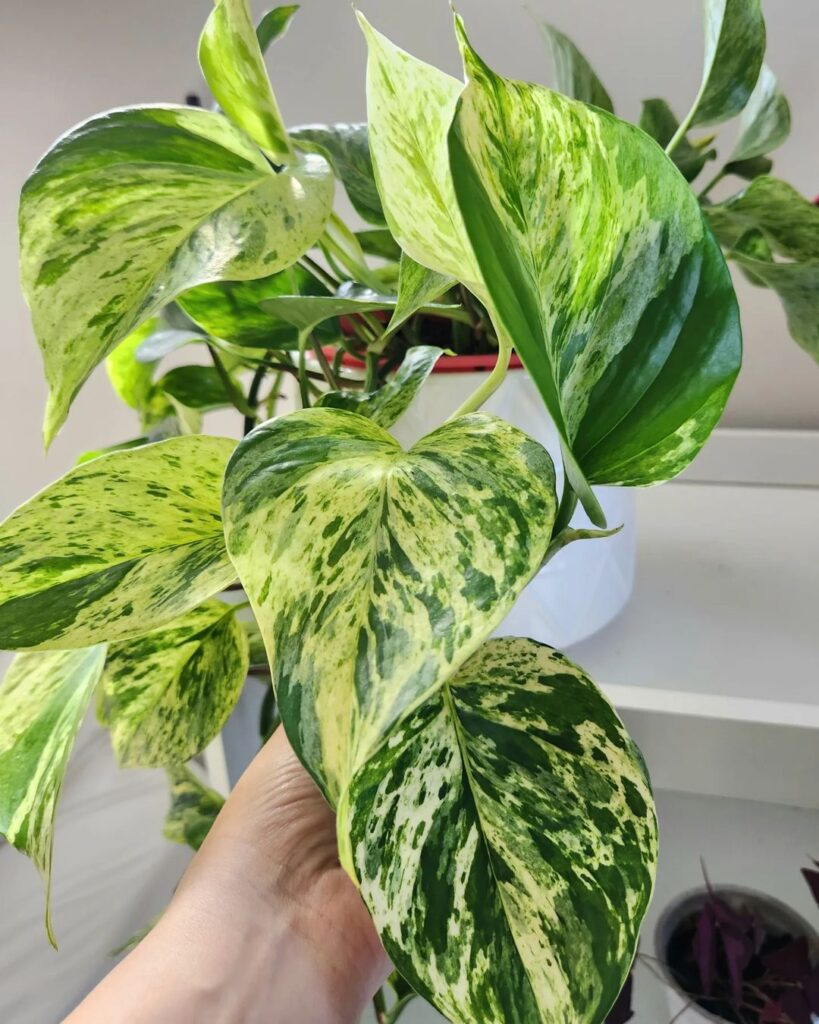
The primary distinction between Marble Queen and Snow Queen Pothos is the color of the leaves. Instead of being white, Marble Queen has a creamy tint. On the other hand, the snow queen leaves have purely white variegation and are much less green.
The last difference between the two is that Snow Queen grows a little more slowly than that of the Marble Queen. Due to their quick development, Marble Queen pothos require trimming, whilst Snow Queen pothos maintain compactness for a longer time period.
These two varieties of pothos plants may initially appear to be identical. We will go into detail about the key distinctions between these two plants as well as their commonalities.
Marble Queen and Snow Queen Similarities
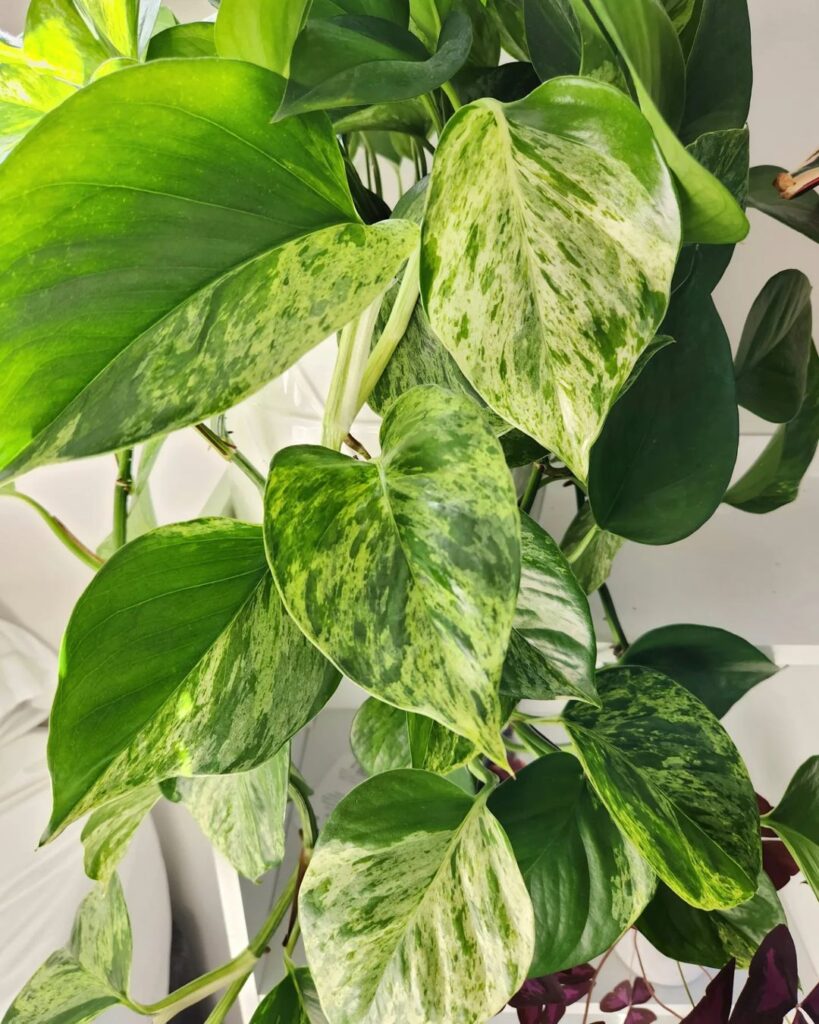
Leaf Texture
Beautiful leather-like leaves with a glossy shine can be found on a healthy Marble Queen and Snow Queen. The leaves of the Snow Queen and Marble Queen both exhibit a faint waxy texture. You can feel the texture is slightly elevated on the leaf if you lightly brush your fingertips across it. However, you can tell them apart based on the color of their mature leaves.
The leaves’ form also evolves as they get bigger. As a result, they may appear malformed when they are young and just beginning to grow.
You shouldn’t worry about that. You’ll see that they have developed into that lovely heart shape you love once they are in their full form.
Presence of Aerial Roots
Aerial roots are roots that emerge from the vine, for those who are unfamiliar with the phrase. As they cling to their environment, they permit the plant to climb.
Aerial roots can be found on both Snow Queen and Marble Queen pothos. As a result, they can climb, develop, and adapt to any environment. So give your pothos plants a fun environment to develop by being inventive!
Related: Pothos Vs. Philodendron: How To Tell Between The Two Popular Houseplants?
Marble Queen and Snow Queen Differences
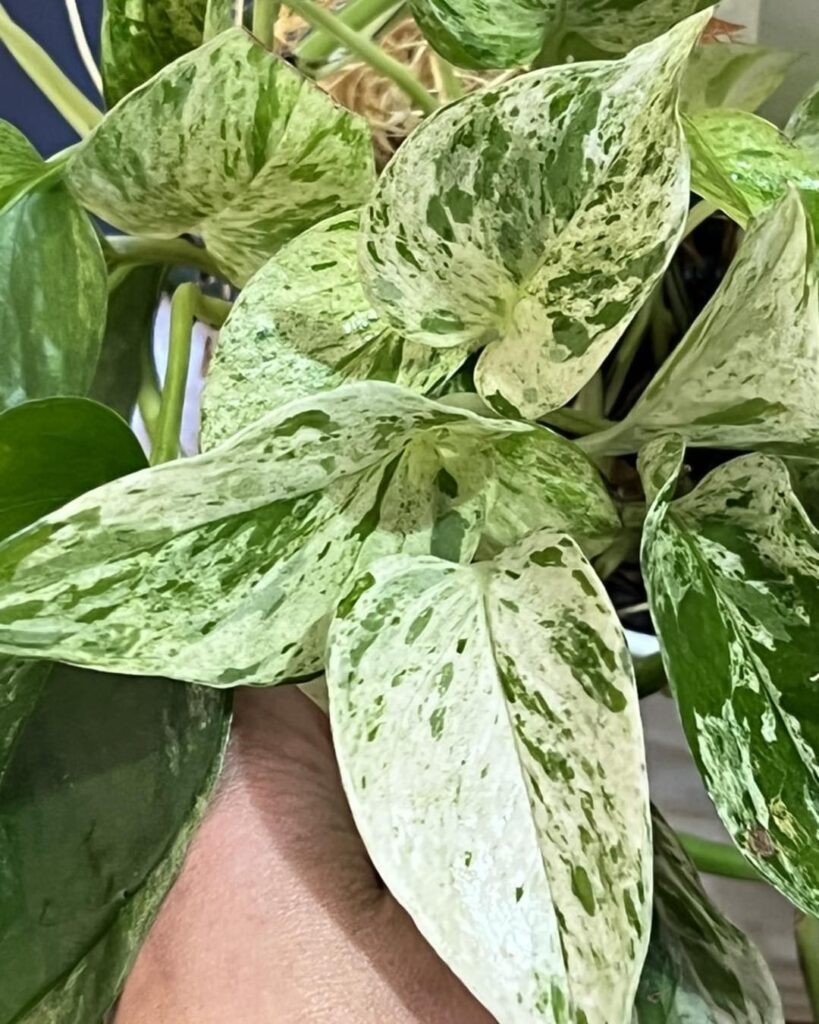
Leaf Characteristics
It’s interesting to note that both of the plants have leaves that are around the similar in size. They will be slightly smaller than plants grown in soil or in their natural environments if you grow them in pots.
The leaf’s shape hasn’t changed all that much, either. They can be distinguished from each other by having leaves with pointy tips that are heart-shaped. It’s a wonderful contrast that Snow Queen’s points are a little bit sharper than Marble Queen’s.
The degree of variegation, however, is what really distinguishes the leaves. Both types of leaves are green at the time of unfurling when the plant’s leaves first start to unfold. However, they exhibit varying degrees of variegation as they age.
Compared to Marble Queen Pothos, Snow Queen Plant has a substantially higher percentage of chlorophyll-free tissues. The outcome is that around 80% of the plant leaf is more white, while the remaining 20% is green.
On the plant leaf, the green color shows sparingly rather than on the whole of it. It also has a slight green tint, making the white more apparent. As a result, the leaf might appear partially translucent at times.
Plant Growth
Because the leaves of the Marble Queen Pothos are a lot more chlorophyllous than that of the Snow Queen, they appear greener.
Snow queen takes longer to mature than marble queen. This could be seen as either a plus or a negative. The Marble Queen Pothos is a fantastic option to take into consideration if you’re looking for a hardy plant.
If the correct circumstances are present, these two Pothos plants have the capacity to reach lengths of feet. It may reach a length of more than 6 feet in its natural state.
In terms of height as a whole, the Snow Queen Plant is nearly the similar size with the Marble Pothos variety. The distinction in this instance is that this plant will take more time to grow to that size. More so, if you like small-sized plants, this one might be perfect for you.
They can both climb well. Because of this, if you grow these plants in hanging containers or pots, they look fantastic on your balcony. However, they appear mostly natural when hanging from a low support.
The marble queen Pothos requires more water and nutrients than the snow queen variety since it develops more quickly. Additionally, make sure the pot you choose for the marble queen is the same size as the snow queen.
Additionally, choose a smaller pot if you prefer your marble queen pothos to be compact or bushy. In addition, to keep them looking bushy, you must occasionally trim the top leaves and roots.
Leaf Sheath
The peculiarity of pothos plants comes from the fact that their individual leaves do not emerge from sheaths. Instead, both the Snow Queen and Marble Queen pothos have leaves that just spread out from the vine.
The plant you have might be a philodendron if it has tiny sheaths. However, you can be confused by several other plants that look the same as Pothos. Remember that neither the Snow Queen nor the Marble Queen Pothos produces leaves from the sheaths.
Petiole
A petiole is the component of any plant that joins the leaf to the vine. Pothos plants have relatively rounded, slightly indented petioles. Petioles on the Marble Queen and Snow Queen pothos are identical in size and texture.
However, Snow Queen Plants are far whiter than the Marble Queen, as we already know. You can frequently tell that Snow Queen has whiter petioles than the other plant when comparing the two.
Depending on the plant, Snow Queen’s petioles can occasionally be all-white.
Habit of Growth
Marble Queen pothos develops more quickly than Snow Queen. They share the same plant family, hence their growth patterns are largely the same.
They can reach heights or lengths up to 2.0 meters (5 ft) when grown indoors. Both of these plants are strong and incredibly versatile.
They can dangle from a basket, or grow all over your home. However, snow Queen is a slow-growing plant, so it would be simpler for you to maintain a bushy appearance.
New Leaf Growth
Marble Queen and Snow Queen pothos’ leaves gradually enlarge as they develop. With these plants, you never know what you’re going to get, just like when you open a birthday present. That, in my opinion, is the fun of it all.
Both Marble and Snow Queen pothos have new leaves that can emerge entirely green. However, you shouldn’t be concerned because they will eventually turn white.
On Snow Queen Pothos, the young leaves are frequently almost entirely white rather than green. Your Marble Queen may also be like this, albeit to a lesser extent. Overall, the amount of light received by these two plants affects their variegation as well as the color of their new leaves.
When it comes to new development with these plants, there are no hard and fast rules. They act independently, changing even their shape as the leaves enlarge. Nothing is wrong, even if the young leaves appear to have been bitten on.
They will eventually reach 91 cm (3 feet) in length and take on the lovely heart form that we are all familiar with.
Related: What Type of Pothos Do I Have? Let Us Solve the Puzzle!
Differences in Taxonomy
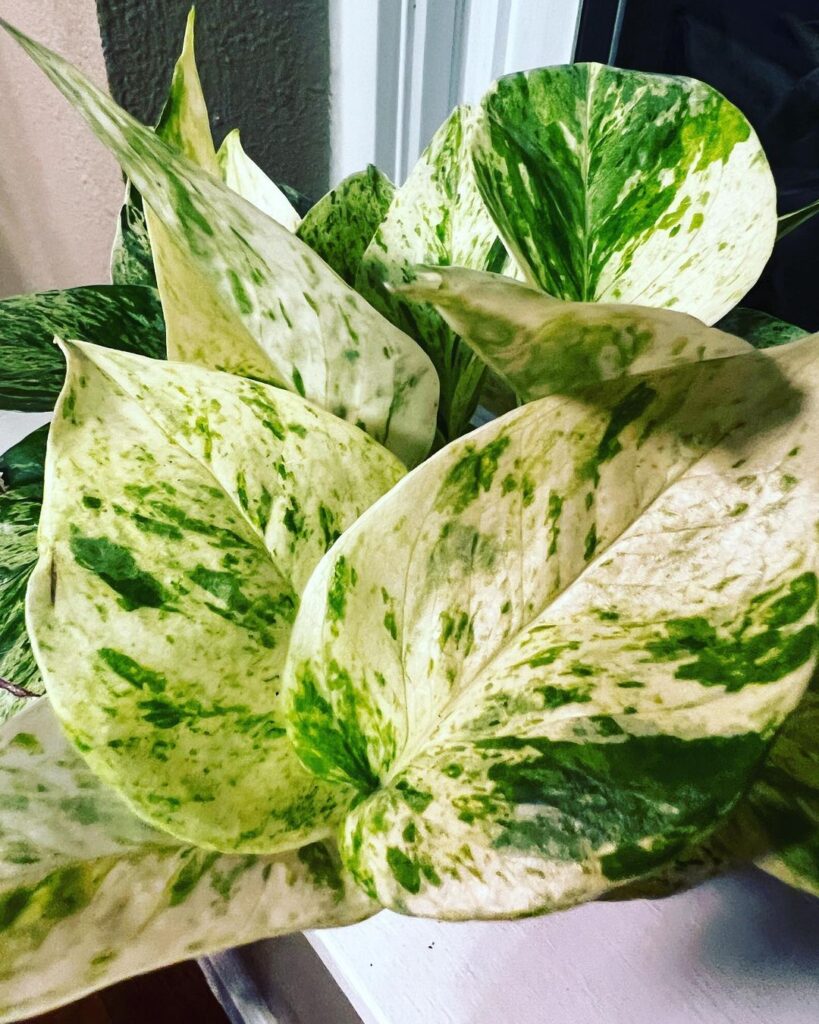
Typically, Pothos plants are classified as belonging to the Epipremnum aureum species. Additionally known as Epipremnum pinnatum, Rhaphidophora aurea, and Scindapsus aureus at times. Hence, they are of the same species, but have different variants.
There are numerous variants of Pothos that go by either of those names. The most well-known ones include Silver Vine, Marble Queen, Snow Queen, Devil’s Ivy, and Golden Pothos.
Knowing the taxonomy won’t be very helpful in figuring out the differences between Snow Queen and Marble Queen Pothos because they belong to the same family.
Differences In Susceptibility To Fungus
The Snow Queen plant grows more slowly and is more susceptible to fungal diseases and other pest-related illnesses such as spider mites, as a result of the decreased amount of green pigment on its leaves. However, this is especially true for illnesses caused by fungi.
Damage from fungus spores is more likely to affect Snow Queen. Brown stains on the leaves are usually how you can see this.
To begin with, choose a location for the Snow Queen that has good airflow. This means there shouldn’t be any plants or anything within one foot of the plant that would obstruct airflow. The space where the Snow Queen is growing needs to be properly ventilated.
The plant shouldn’t receive too much water. Give it adequate sunlight as well. Additionally, you must always be ready to treat the illness if it has already infected your plant. The Marble Queen fits with this as well. Although it is more resistant to damage than a rival, this kind is nonetheless susceptible.
At the first symptom of the disease, you must spray fungicide on Pothos to cure it (spots on the leaves). There are lots of great indoor-use goods available on the market. Pick the best one and follow the instructions in the manual. One therapy is frequently insufficient, so try it again later.
Growth Requirements
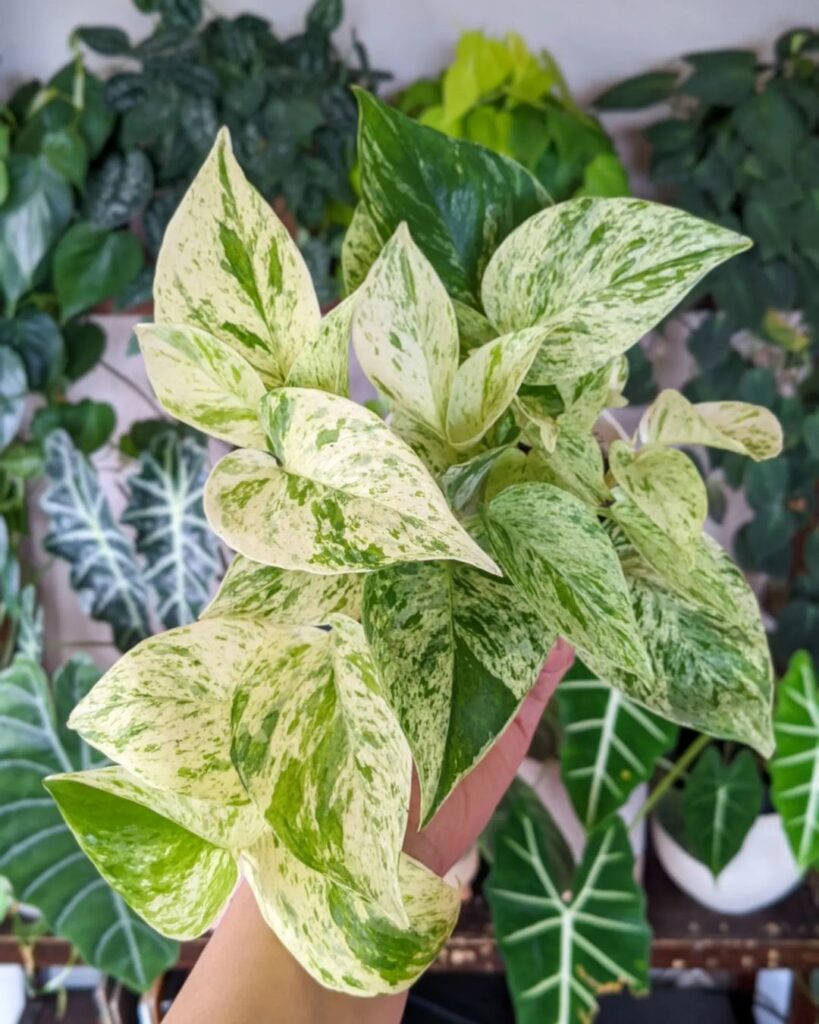
Both the Marble Queen Pothos Care and Snow Queen pothos have quite similar growing requirements. Therefore, we will go over each criterion in depth in order to assist you in identifying the type of plant.
Soil Needs
The Snow Queen Pothos is a relatively low-maintenance plant that requires little effort. So that you can prevent root rot, fast-draining soil is the finest kind for your Snow Queen.
You might mix small pebbles into the dirt at the bottom of the container to make it quickly drain. If you don’t have the time to produce your own potting soil, cactus plant potting soil will work just fine.
They are essentially the same when it comes to Marble Queen soil needs. They require soil that is nutrient-rich and well-draining.But be careful not to make the soil too thin. The Marble Queen requires wet soil. The ideal soil would be one that contained equal amounts of peat moss, perlite, and normal houseplant soil.
Pots/Containers
A pot with enough drainage holes is necessary for both these plants, the Marble Queen and Snow Queen pothos. It is essential that the water drains out and stays in the soil, keeping it wet.
You might use a pole to force your Marble Queen or Snow Queen pothos to climb rather than hang. You can use your imagination at this point. These plants can cling to and wrap themselves around almost anything.
You can plant them in big containers or hanging baskets if you wish to cultivate them as hanging plants. Your Queen Pothos plants are extremely adaptable and have limitless options.
Light Requirement
The variation of the Snow and Marble Queen Pothos is primarily caused by light. The amount of light the plant receives greatly impacts the color of the leaves.
The lighting requirements are the same for all variegated varieties of pothos plants. Consequently, they flourish in regions with only partial light or in areas with indirect sunshine.
If you place them in direct sunlight, your Marble Queen or Snow Queen pothos’ color may fade.
Temperature Requirement
Like the rest of their Pothos family, Snow Queen and Marble Queen prefer the indoors as they are indoor plants. The essential thing to keep in mind is to prevent abrupt temperature swings.
Overall, ordinary room temperatures are ideal for Snow Queen and Marble Queen pothos. For the Queens, maintaining a constant temperature between 18°C and 23°C (65°F and 75°F) would be ideal.
Related: Why Are The Leaves Turning Yellow? 8 Reasons Why Your Pothos Is Changing Color
Watering Requirement
Pothos like the Marble Queen and Snow Queen enjoy wetness, but drainage is crucial. Therefore, it is crucial to avoid overwatering these plants as a result.
Once every week, you ought to water your Marble Queen. First, check if the soil’s top 2.5 to 5 cm (1″ – 2″) is dry to see if your Marble needs watering. You can now water your Marble Queen without risk.
The Snow Queen pothos is the same. They like their soil to be a little bit drier. So your Snow Queen is prepared for watering if the soil is entirely dry. As a general rule, all pothos plants should be watered more in the summer. However, watering as often in the winter is not required.
Fertilizer Requirement
Pothos like Marble and Snow Queen seldom ever require fertilizer. According to some, they can survive quite fine without you ever applying any additives.
However, there are a few choices available if you decide to fertilize them. First, it is best to fertilize Marble Queen pothos once a month while it is growing. Because of how slowly they grow, fertilizing them during the season would help. But, for them, standard, diluted houseplant fertilizer would be plenty.
A delayed release would be a fantastic choice for Snow Queen. In addition, organic fertilizers like worm castings or seaweed solutions would be a terrific addition to these plants.
In general, fertilizers shouldn’t cause you too much concern. Snow Queen and Marble Queen are both excellent choices for those who don’t have a lot of spare time.
Plant Positioning
The best location for these plants to thrive to their fullest potential is one aspect of care that applies to both of them. Both like a sunny space without drafts because neither can tolerate direct sunshine.
Pothos can grow in low light environments, however, growth will be slower. They will also start to lose their variegation in an effort to make up for the poor development by making more chlorophyll.
Avoid exposing the Snow Queen to any direct sunlight and keep her in partial light for at least six hours each day.
Place the Marble Queen away from direct sunlight and in a naturally lit area. To promote even development, keep rotating your Pothos every few days. Keep the grow lamp 1 to 2 feet away from your plant if you decide to use it to keep plants warm and increase light throughout the winter. This will aid in preventing leaf burning.
Misting Requirement
Misting Pothos is a regular query about caring for them. The quick answer is that Pothos thrive in environments with humidity levels between 50 and 70 percent.
The more detailed response is that it depends on the humidity levels in your area. For instance, high-altitude places often have little humidity, therefore, if you want your plant to grow in that environment, you’ll need to supplement the humidity it is exposed to. One method to raise humidity levels is misting.
Just be careful that spraying your plants could result in mold and bugs appearing due to the extra moisture if you reside somewhere where the humidity is high. Root rot may also be a threat to your plant.
Pruning Requirement
Both Snow Queen and Marble Queen benefit from trimming. Pruning them will help you keep them under control because they are wild and active.
I want to keep them bushy because the Marble Queen grows a little more slowly than the Snow Queen. You can accomplish that by trimming the longer stems in the spring.
You don’t have to wait until spring to prune your plant’s dead and damaged leaves. It would not matter when in the year, either. Trimming new growth will eventually result in a fuller plant if you want your plant to be bushier.
When it comes to Snow Queen pothos, little has changed. Regularly trim the leaves that are yellowing and withering. Before your plant becomes too lanky, prune the vines if you want your Snow Queen to be bushy as well.
Flowering
A cream spathe with purple markings surrounding the spadix can be found on each of the stalk-like flowers that Pothos can grow in the wild. It resembles the flower of the peace lily very much.
Because Pothos flowers simply don’t grow as large indoors and are frequently cut back and maintained to a more confined size, it is uncommon to see them in bloom.
Final Thoughts
In general, guidelines for one variety of pothos plant typically apply to the majority of the other species. The primary distinction between them is the type of variegation.
As the name implies, Snow Queen pothos produces more white than green leaves. Therefore, the primary distinction between Snow and Marble Queen is this. It is also the simplest way to tell these two plants apart.
Frequently Asked Questions
How is Marble Queen pothos kept white?
Moving your Marble Queen to a more sunny location should restore the color if it has lost any of its white hues. Unfortunately, the leaves of your plant won’t change back after they have turned totally green. So it’s best to see this right away!
How can I maintain the Marble Queen pothos’ variegation?
Plants with variegation require more light. Transfer your plant to a windowsill that receives more sunshine, but take care to keep it out of direct sunlight.
Editor’s Recommendations
Watermelon Peperomia: The Best Steps For Successful Propagation
Philodendron Prince of Orange: The Best Care, Watering, and Propagation Guide
Dying Money Tree: Important Steps and Tips To Revive Your Plant







